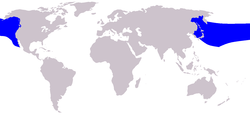Giant beaked whale
|
|
| Giant beaked whales Conservation status: Lower risk | ||||||||||||||||
|---|---|---|---|---|---|---|---|---|---|---|---|---|---|---|---|---|
| Scientific classification | ||||||||||||||||
| ||||||||||||||||
| Binomial name | ||||||||||||||||
| Berardius arnuxii | ||||||||||||||||
| Missing image Cetacea_range_map_Arnoux's_Beaked_Whale.PNG Arnoux's Beaked Whale range Arnoux's Beaked Whale range | ||||||||||||||||
| Binomial name | ||||||||||||||||
| Berardius bairdii | ||||||||||||||||
 Baird's Beaked Whale range |
The genus Berardius contains two species of beaked whale, Baird's Beaked Whale and Arnoux's Beaked Whale. The two species are so similar that some scientists (see e.g. [4]) regard their separation into distinct species as a historical anomaly. The two species are the largest of all beaked whales and collectively they are sometimes referred to as the giant beaked whales.
Baird's Beaked Whale was first described by Leonhard Hess Stejneger in 1883 from a specimen found in the Bering Sea. It is named for Spencer Fullerton Baird, a past Secretary of the Smithsonian Institute. Arnoux's Beaked Whale was described in 1851 by Duvernoy from a skull found in New Zealand. Berard was the captain of the ship that carried the skull from New Zealand to France where Duvernoy analysed it. Arnoux was the doctor on board the ship. [6]
| Contents |
Physical description
The two species have very similar features and would be indistinguishable at sea if they did not exist if disjoint locations. Arnoux's is generally shorter. Estimated lengths of live Arnoux's at sea have been up to 12m but all dead specimens have been considerably smaller. The Baird's on the other hand have been confirmed to grow to 12-13m.
Both whales have a very long prominent beak, even by beaked whale standards. The lower jaw is longer than the upper and the front teeth are visible even when the mouth is fully close. The melon is particularly bulbous. The body shape is slender - the girth is only 50% of length. The body is uniformly coloured and a particular individual's colour may anything from light grey through to black. The flippers are small, rounded and set towards the front of the body. The dorsal fin similarly is small and rounded and set about three-quarters of the way along the back. Both species pick up numerous white scars all over the body as they age and may be a rough indicator of age. There is little sexual dimorphism in either species.
Population and distribution
The two species ranges do not overlap and this perhaps the most significant reason why historically they have been treated as separate species.
Arnoux's inhabit great tracts of the Southern Ocean. Beachings in New Zealand and Argentina indicate that the whale is relatively common in the areas south of those countries down to Antarctica. It has also been spotted close to South Georgia and South Africa, indicating a likely circumpolar distribution. The northernmost stranding was as 34 degrees south, indicating that whale inhabits cool and temperate as well as polar waters.
Baird's Beaked Whale is found in the North Pacific Ocean, the Sea of Japan and the southern part of the Sea of Okhotsk. They appear to prefer seas over steep cliffs at the edge of the continental shelf. Specimens have been recorded as far north as the Bering Sea and as far south as the Baja California peninsula on the east side and the southern islands of Japan on the west.
The total population is not known for either species. Estimates for Baird's are of the order of 30,000 individuals.
Behaviour
Little is known about the behaviour of Arnoux's Beaked Whale but is expected to be similar to that of Baird's. The whales normally move in close-knit groups of about 3-10, with groups of 50 observed in exceptional circumstances. Considering the extent of whaling of the species, the pod structure is not well known. One interesting curiousity is that two-thirds of all whales caught have been male, despite the fact that females are somewhat larger than males and thus would be the preferred targets for whalers, if they were as easy to catch.
Conservation
Arnoux's Beaked Whale has never been exploited and although no abudance estimates are available, the population is not believed to be endangered.
In the twentieth century Baird's was hunted primarily by Japan and to a lesser extent by the USSR, Canada and the United States. The USSR reported killing 176 individuals before hunting ended in 1974. Canadian and American whalers killed 60 before halting in 1966. Japan killed around 4000 individuals before the 1986 morartorium on whaling. 300 were killed in the most prolific year, 1952. Under the terms of the morartorium a quota was introduced and now 62 animals are killed each year for scientific research, with the meat being sold in local markets. The species is not believed to be threatened by this level of hunting.
Common names
- B. arnuxii Arnoux's Beaked Whale, Southern Four-toothed Whale, Southern Beaked Whale, New Zealand Beaked Whale, Southern Giant Bottlenose Whale, Southern Porpoise Whale
- B. bairdii Baird's Beaked Whale, Northern Giant Bottlenose Whale, North Pacific Bottlenose Whale, Giant Four-toothed Whale, Northern Four-toothed Whale, North Pacific Four-toothed Whale
References
- Giant Beaked Whales in the Encyclopedia of Marine Mammals pages 519-522 Teikyo Kasuya, 1998. ISBN 0125513402
- National Audubon Society Guide to Marine Mammals of the World Reeves et al, 2002. ISBN 0375411410.
- Whales, Dolphins and Porpoises Carwardine, 1995. ISBN 0751327816
- A study of the genus Berardius McCann, 1975. Sci. Rep. Whales Res. Inst. Vol 27, 111-137.
- An image of a Baird's Beaked Whale at monteraybaywhalewatch.com (http://www.montereybaywhalewatch.com/phbairds.htm)
- cetacean.org on the origin of the species' names (http://www.cetacea.org/arnouxs.htm)de:Schwarzwale
